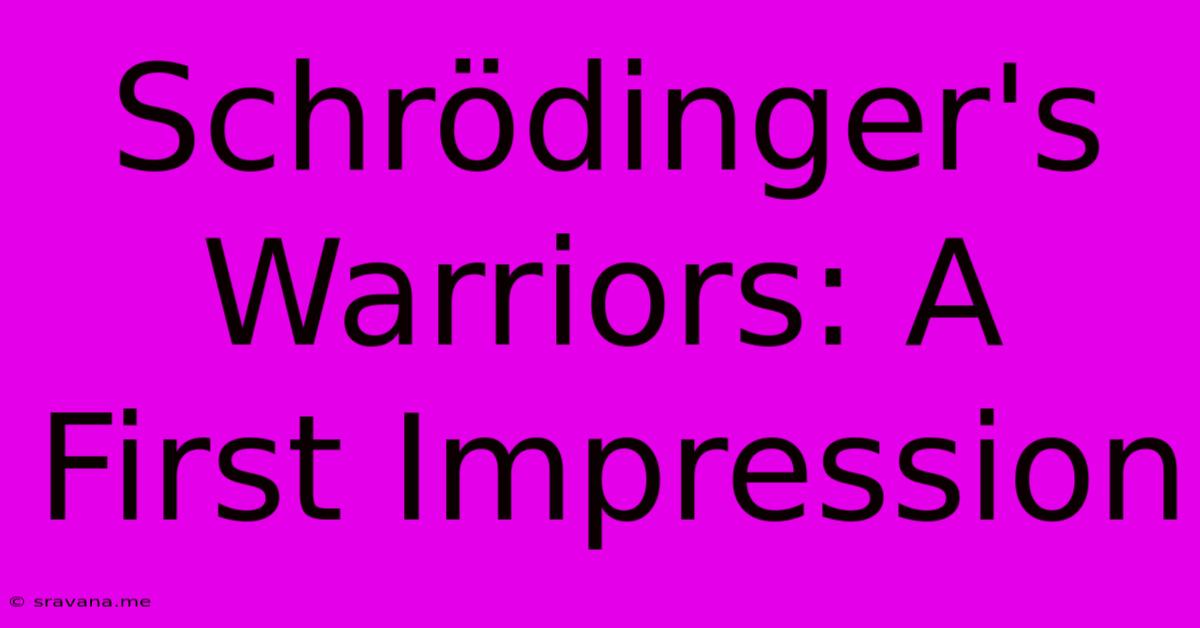Schrödinger's Warriors: A First Impression

Discover more detailed and exciting information on our website. Click the link below to start your adventure: Visit Best Website sravana.me. Don't miss out!
Table of Contents
Schrödinger's Warriors: A First Impression
Schrödinger's Warriors, the intriguing new strategy game from [Developer Name], presents a fascinating blend of real-time strategy (RTS) and turn-based tactics. Its unique premise, where units exist in a superposition of states until observed, offers a fresh take on the genre, demanding a strategic approach far beyond simple unit micromanagement. This first impression delves into the game's mechanics, its strengths, and areas where it could benefit from further refinement.
A Quantum Leap in Strategy Gaming?
The core gameplay revolves around the "Quantum Core," a central mechanic that allows you to manipulate the probability of your units' states. Before combat, units exist in a probabilistic state – they are simultaneously present and absent, highly mobile and immobile, offensive and defensive. It's only when they're "observed" through direct engagement or the use of specific abilities that their true state is determined. This introduces an unprecedented layer of strategic depth.
Probabilistic Warfare: The Core Mechanic
Imagine deploying a squad of soldiers; before combat, they exist as a blurry cloud of potential. They could be highly armored and slow, or fast and lightly armored – a gamble determined only when the enemy engages. This necessitates careful planning, anticipating enemy movements and positioning your units to maximize the chance of desired outcomes. It's a fascinating dance of risk and reward. Miscalculate the enemy's response, and your "strong" unit might collapse into a fragile state, easily eliminated.
Unit Composition and Synergies
The game boasts a diverse roster of units, each possessing unique probabilistic traits. This isn't merely a matter of hit points and damage; the probabilities themselves are often crucial to victory. A highly mobile, low-health scout unit, for example, might have a high chance of appearing in a flanking position if observed by the enemy, while a heavy tank could have a low chance of being heavily armored, offering an enticing bait for the unwary. The synergies between these units are intricate, making experimentation and strategic adaptation critical.
Map Design and Tactical Implications
The level design greatly enhances the quantum mechanics. Maps feature areas of heightened observation, influencing the probabilities of your units’ states. These "observation points" often function as choke points or strategically important locations, adding another layer of complexity. Positioning your units strategically around these points, controlling their visibility and interaction, is key to outmaneuvering the opponent. Each map presents unique opportunities and challenges, encouraging replayability.
Strengths: Innovation and Strategic Depth
Schrödinger's Warriors shines brightest in its innovation. The probabilistic gameplay is not a gimmick; it’s genuinely impactful, forcing players to think several steps ahead. The game demands a comprehensive understanding of unit stats, map layouts, and enemy behavior to consistently succeed.
- High Replayability: The probabilistic nature of the units and the dynamic map interactions ensure that every playthrough feels fresh and unpredictable. No two battles will ever be the same.
- Strategic Depth: Mastering the quantum core requires significant strategic thinking, rewarding careful planning and adaptability.
- Unique Selling Point: The central mechanic sets it apart from the crowded RTS landscape, offering a truly unique gaming experience.
Areas for Improvement: Complexity and Accessibility
While the innovative gameplay is commendable, the steep learning curve presents a significant hurdle for newcomers. The sheer number of variables and the probabilistic nature of combat can be overwhelming at first.
- Tutorial and Guidance: The tutorial could benefit from a more gradual introduction to the quantum mechanics. The current system might leave new players feeling lost and frustrated. Clearer explanations of unit stats and probabilistic modifiers are needed.
- User Interface (UI): The UI could be improved for clarity and intuitiveness. Visual representations of unit probabilities and map observation points need to be more easily digestible.
- Balancing: While the current balancing seems reasonably fair, prolonged play might uncover imbalances between different units or strategies. Continued monitoring and adjustments will be necessary.
Long-Term Potential: A Growing Quantum Universe
Despite the initial hurdles, Schrödinger's Warriors possesses immense long-term potential. The core gameplay loop is engaging, and the possibilities for expansion are vast. Future updates could introduce:
- New Units: Expanding the unit roster with units possessing even more complex probabilistic traits.
- New Maps: More diverse and challenging maps with varying observation points and terrain features.
- Multiplayer Modes: Implementing robust online multiplayer modes would significantly enhance the replayability and competitive aspect.
- Campaign Mode: A detailed campaign mode with a compelling narrative would add another dimension to the game.
Conclusion: A Promising Start
Schrödinger's Warriors offers a genuinely innovative and engaging take on the RTS genre. While the initial learning curve is steep, the strategic depth and unique gameplay mechanics more than compensate. With further refinement to the tutorial, UI, and potentially some balancing tweaks, Schrödinger's Warriors could become a true standout title in the world of strategy games. Its potential is immense, and this initial impression leaves me eager to see how the game evolves and expands in the future. It's a quantum leap in the right direction.

Thank you for visiting our website wich cover about Schrödinger's Warriors: A First Impression. We hope the information provided has been useful to you. Feel free to contact us if you have any questions or need further assistance. See you next time and dont miss to bookmark.
Also read the following articles
| Article Title | Date |
|---|---|
| Currys Fg Drought Warriors Lose To Grizzlies | Dec 22, 2024 |
| Wind Warning Issued Devon Somerset Sunday | Dec 22, 2024 |
| Warriors Vs Grizzlies Final Score Memphis Wins | Dec 22, 2024 |
| Grizzlies Historic 51 Point Win Vs Warriors | Dec 22, 2024 |
| Divorce Statement Lilly Jay On Ethan Slater | Dec 22, 2024 |
